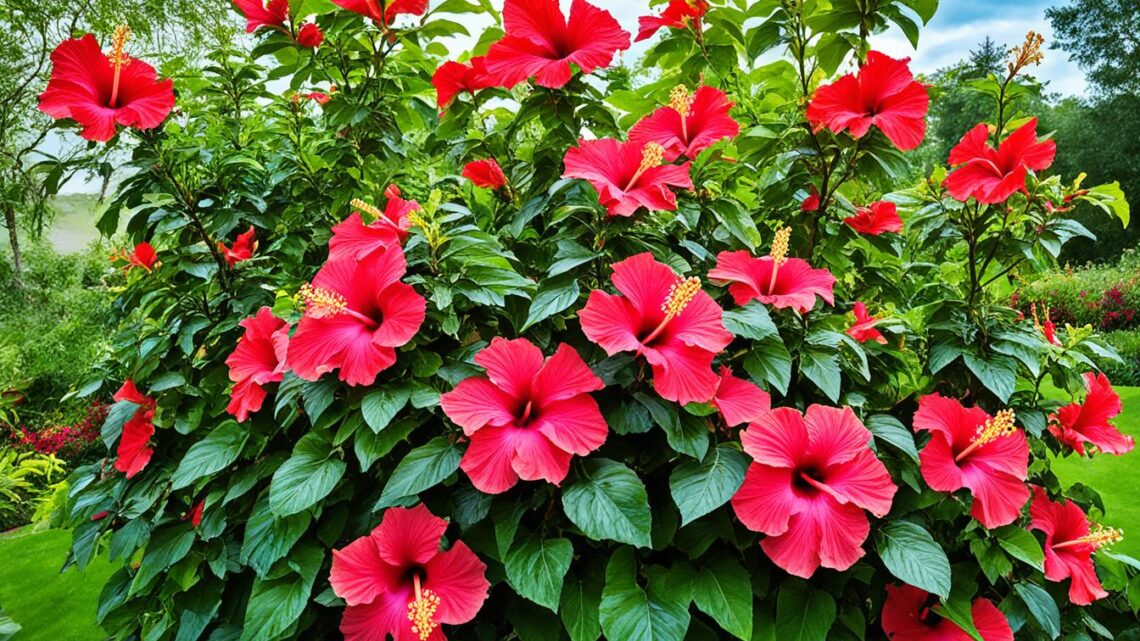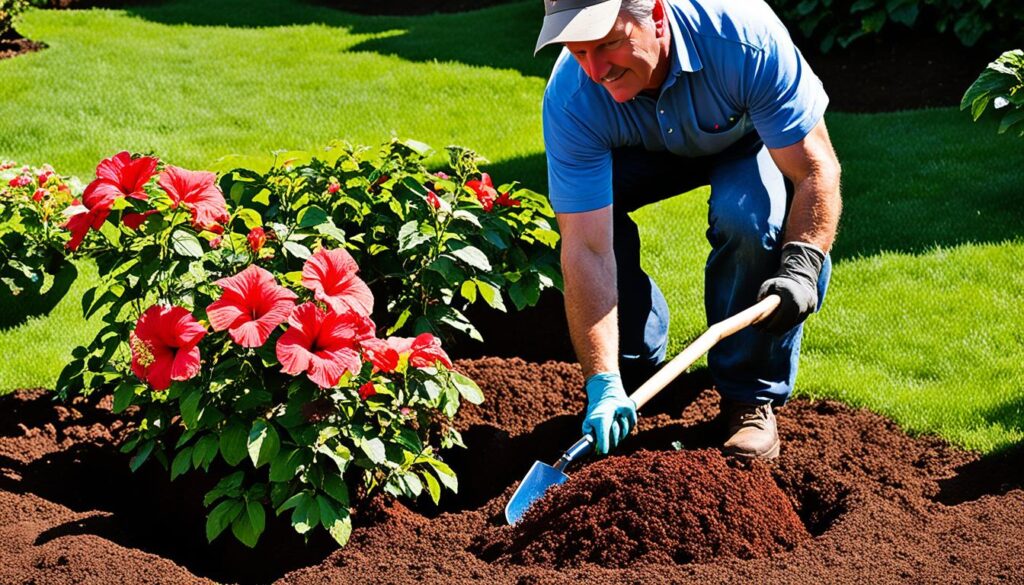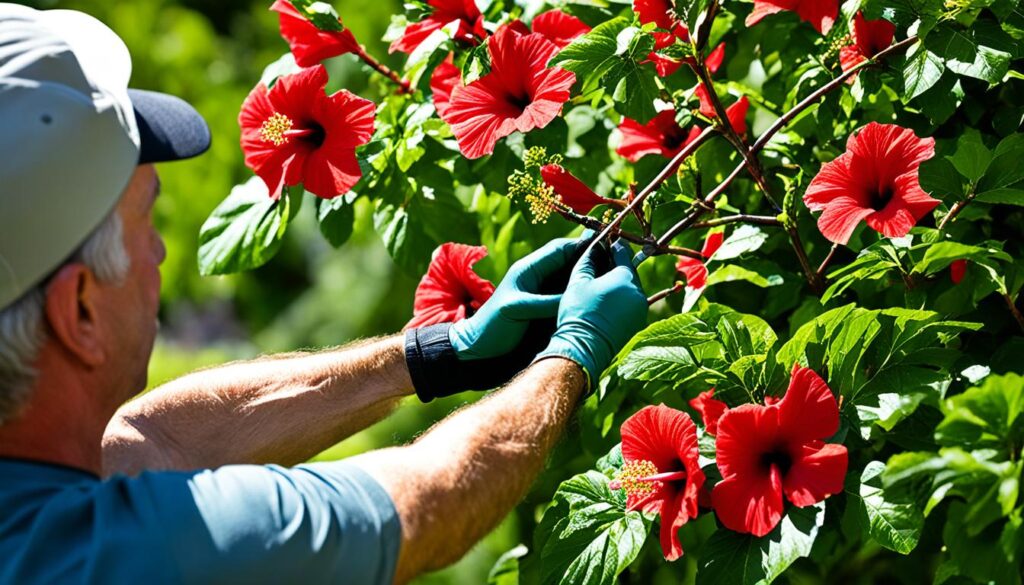
Have you ever wanted your garden to feel like a tropical paradise? Well, hibiscus trees can make that dream a beautiful reality. These stunning hibiscus plants are a delight to look at and simple to care for. They’re perfect for everyone, whether you’re a green thumb or just starting.
Picture your garden coming alive with these tropical hibiscus becoming the stars. But hold on; do you know how to keep them happy and healthy?
Introducing the Captivating Hibiscus Tree
The hibiscus plant (H. rosa-sinensis) is known for its stunning hibiscus flowers. These flowers pull in butterflies and hummingbirds, making your garden lively. They come in colors like red, yellow, and pink. With proper care, they bloom all the way from spring to fall.
Vibrant Trumpet-Shaped Blooms
Hibiscus belongs to the mallow family (Malvaceae) and grows in tropics and moderate areas. There are hundreds of hibiscus varieties around the globe. Its species have different colors and some have double flowers.
Subtropical Woody Shrub
The hibiscus plant (H. rosa-sinensis) is known for its stunning hibiscus flowers. These flowers pull in butterflies and hummingbirds, making your garden lively. They come in colors like red, yellow, and pink. With proper care, they bloom all the way from spring to fall.
Easy to Care For
Hibiscus is part of the mallow family (Malvaceae) and grows in tropics and moderate areas. It includes the popular rose of Sharon (Hibiscus syriacus). There are many hibiscus varieties with vibrant colors. Plus, new kinds are always appearing.
Selecting the Perfect Hibiscus Tree
Choosing a hibiscus plant starts with looking for vibrant, green leaves that are free from marks. Look for a healthy hibiscus at local nurseries. You can plant it in the ground or a container. A good hibiscus choice has many flower buds. These beautiful flowers come out in early spring, but this timing can change depending on the care and type.
Look for Healthy Green Leaves
Healthy hibiscus plant leaves are a deep, green color with no damage. Be careful to avoid ones with yellowing, wilting, or damaged leaves. They might have hidden problems that could affect their growth.
Choose Plants with Developing Flower Buds
When picking a hibiscus, go for those with lots of budding flowers. Seeing buds starting to open means the plant is in good shape. Check the stems and branches to make sure the buds look healthy.
Planting Your Hibiscus Tree
To start your hibiscus off right, pick the best spot and prep the soil. This is crucial before you actually plant it.
Finding the Ideal Location
Choose a sunny place in your yard, getting 6 to 8 hours of sunlight each day. Hibiscus likes soil that doesn’t hold too much water. Well-drained areas are best to avoid the plant from sitting in water.
Preparing the Soil
Mix compost and earthworm castings into the soil before planting. This improves the soil, making it just the right acidity and full of nutrients. A pH of 6.5 to 6.8 is what hibiscus loves.
Planting in the Ground or a Container
For the ground, make a hole bigger than the plant’s root ball. Set the root ball in, keeping it level with the ground, and fill in the hole. Hibiscus in a pot should be in a mix that drains well and is good for acid-loving plants.

Caring for Your Hibiscus Tree
It’s key to offer the perfect environment for your hibiscus tree. This ensures it’s full of life with vibrant flowers and green leaves. We will go through everything you need to know about hibiscus care. This includes the right sunlight, watering, and feeding it.
Sunlight Requirements
Hibiscus plants love to soak up the sun. They bloom best with six to eight hours of direct sunlight daily. Pick a spot in your yard that gets lots of sun. This is vital for your hibiscus to grow well.
Watering and Soil Needs
The soil around your hibiscus should be damp, not soaked. For the first week, water it every day. Then, water it only twice a week if it hasn’t rained. Remember not to spray water on the hibiscus foliage. Wet leaves can cause diseases.
Fertilizing for Optimal Growth
To see your hibiscus thrive, they need the right food. Give your hibiscus plant food every two weeks. Use a fertilizer made for blooming plants. Plus, once a month, use Pennington UltraGreen Palm Tree & Hibiscus Plant Food 9-4-9. This keeps the leaves a deep, dark green.

Pruning Your hibiscus tree
Keeping your hibiscus tree well-pruned is key for good growth and lots of flowers. Hibiscus flowers last just a day before they close and fall off. Regular pruning keeps your tree neat and pretty.
Prune hibiscus plants you’ll have indoors or outdoors in a warm area by one-third in late winter or spring. This helps new growth and many flowers. Cut off any branches that cross or are dead. Make all stems the same length.
Aside from cutting off old flowers, regular hibiscus pruning keeps your tree healthy and beautiful. Follow these pruning tips to see your hibiscus bloom brightly for a long time.

Overwintering Your Hibiscus Tree
If you live in a cold place, bringing your hibiscus indoors in winter is a must. This way, you keep your plant safe and healthy. Overwintering hibiscus helps your plant stay strong till spring.
Bringing Plants Indoors
First, cut off all the dead or broken branches. This makes your hibiscus ready for new growth. Then, put mulch around it to keep the roots warm and safe.
Maintaining Care Indoors
When your hibiscus is inside, keep it well-watered but not too much. The soil should stay moist, not wet. Also, put it in a sunny place. Hibiscus loves the light, even in winter.
Propagating Hibiscus Trees
If you want more hibiscus plants or to share their beauty, it’s easy to do. Hibiscus trees can be spread easily. This helps grow a vast range of these tropical flowers in your garden.
Taking Stem Cuttings
In early spring, before the flowers come, it’s time to pick hibiscus cuttings. Look for 6-inch healthy stems without flowers. Cut off the bottom leaves but keep the top ones. This helps the plant focus on growing roots instead of keeping leaves alive.
Rooting the Cuttings
After preparing your cuttings, it’s time to root them. Put the cuttings in a water container and be patient. You need to wait a few weeks for roots to show up. Remember to change the water often. Doing this right, you’ll start seeing roots at the base of your new plants.
Common Pests and Diseases
Hibiscus plants often face problems from various pests and diseases. These can harm the plants’ health and their looks. Hibiscus mealybugs, seen as small white masses, are a major trouble. They appear on leaves, stems, and buds. Proper airflow and keeping infected plants away from healthy ones can help fight off mealybugs.
Mealybugs
Hibiscus mealybugs are a big worry for fans of these plants. These tiny bugs can quickly move to different plants and can cause a lot of harm. It’s key to have good air movement around the plants. Also, keep the affected plants away from healthy ones to control these pests.
Nutrient Deficiencies
Hibiscus trees might also lack the nutrients they need. This can make their leaves yellow in spots. Adding micronutrients like magnesium or iron can help the leaves stay healthy and green.
Mildew and Rust Diseases
Hibiscus is also prone to fungal illnesses like gray mold (botrytis),downy and powdery mildew, and rust. These diseases make the leaves or buds look white, gray, or yellow. Removing the affected parts and using the right fungicides can stop these illnesses from spreading.
Staying alert and acting fast can maintain the health of your hibiscus. This ensures they are full of lush tropical flowers every year.
Diverse Varieties of Hibiscus Trees
Hibiscus trees come in many shapes and sizes. They have hundreds of different types. One favorite is the hibiscus rosa-sinensis.
It is known for its bright, trumpet-shaped flowers. These flowers make any garden beautiful. The hibiscus syriacus is another popular kind. It is also called the Rose of Sharon. It blooms with beautiful flowers in late summer.
Looking for something unique? You might like the hibiscus sabdariffa, or Roselle. It not only has pretty flowers but also edible parts. Many use its calyces to make herbal teas. Whether it’s the eye-catching Jazzy Jewel series or the traditional red hibiscus, there’s a type for everyone.
Are you into vibrant colors, unique shapes, or useful plants? Hibiscus has it all. With so many types of hibiscus, there’s a perfect one for your garden. It will add beauty and charm.



